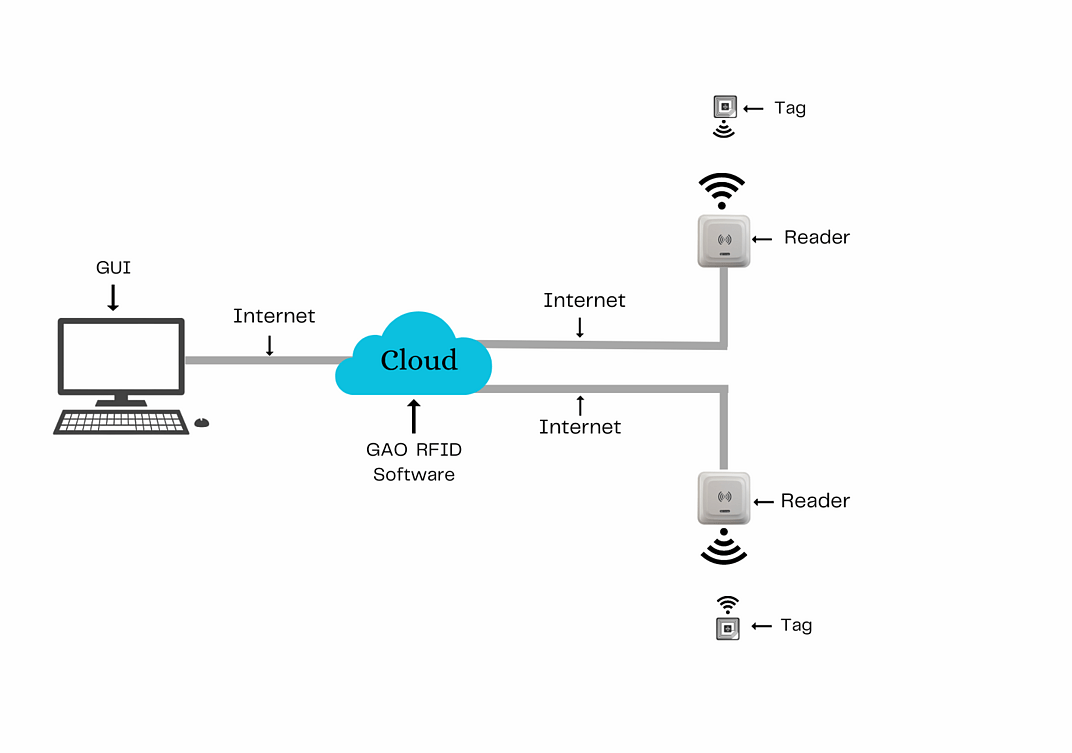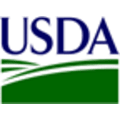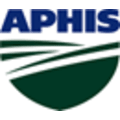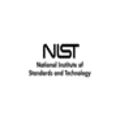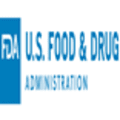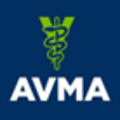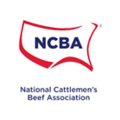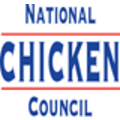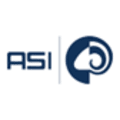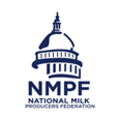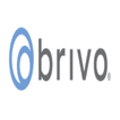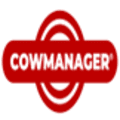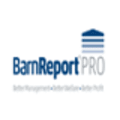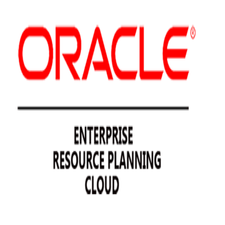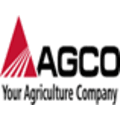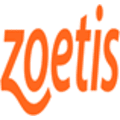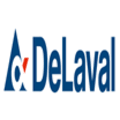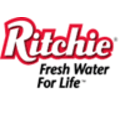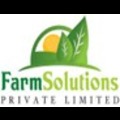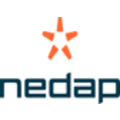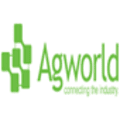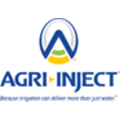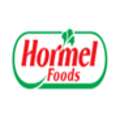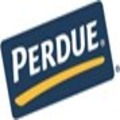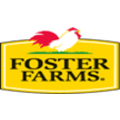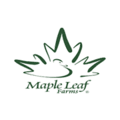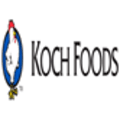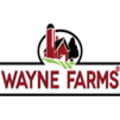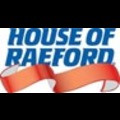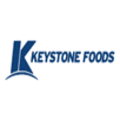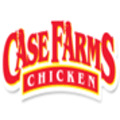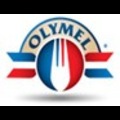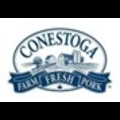Overview
The animal production industry involves the breeding, rearing, and processing of animals for human consumption. It includes a range of activities such as raising livestock (cattle, pigs, sheep, goats, poultry, etc.), fish farming, and other forms of aquaculture. Animal production is a significant part of the agricultural sector and plays an essential role in meeting the world’s demand for food, fiber, and other products.
GAO’s RFID, BLE, IoT, and drone technologies have helped its customers in the Animal Production Industry to improve their work processes, their operations and productivity by better management of their staff, materials and operational equipment such as Livestock handling equipment, Feeding equipment, Watering equipment, Milking equipment, Egg collection equipment, Incubators and hatcheries, Fish farming equipment, Cooling and ventilation equipment, Waste management equipment, Diagnostic equipment.
Ranked as one of the top 10 global RFID suppliers, GAO RFID Inc. is based in New York City, U.S. and Toronto, Canada. GAO offers a comprehensive selection of UHF, HF (including NFC) and LF RFID (radio frequency identification) readers and tags, BLE (Low Energy Bluetooth) gateways and beacons, and various RFID and BLE systems such as people tracking, asset tracking, access control, parking control, fleet management, WIP (work in progress), traceability. Such RFID and BLE products and systems, as well as its IoT and drone technologies, have been successfully deployed for the Animal Production Industry.
Applications & Benefits of GAO’s RFID, BLE, IoT & Drones for the Animal Production
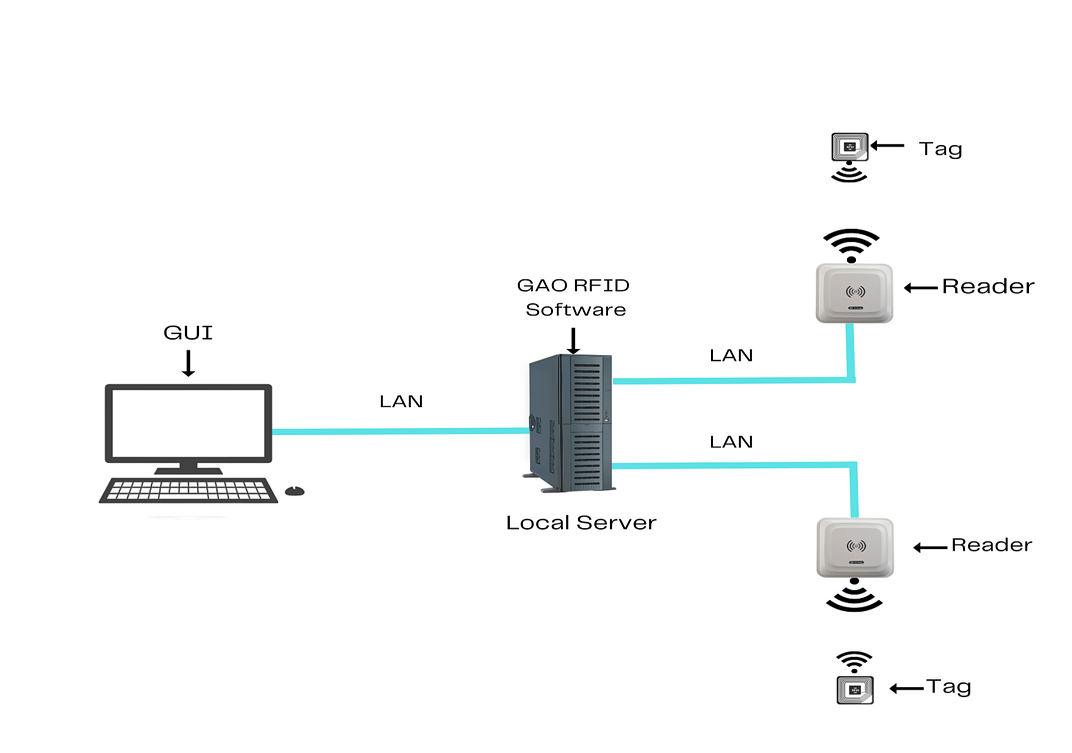
To satisfy its customers, GAO’s RFID or RFID Systems for the Animal Production Industry are offered in 2 versions. One version is that its software is running on a local server, and another version is that its software runs in the cloud. The above illustrates GAO system for the Animal Production Industry with its software running on a local server.
GAO’s RFID technologies bring the many benefits to the animal production industry:
- Increased efficiency: Our RFID technology can automate many tasks in the animal production process, reducing the need for manual labor and increasing efficiency.
- Improved inventory management: GAO’s RFID technology can be used to track inventory levels of animal feed, equipment, and other supplies, ensuring that farmers always have the necessary resources on hand.
- Better data management: Our RFID technology can be integrated with data management systems to collect and analyze data on animal health, productivity, and other key metrics. This can help farmers identify areas for improvement and make data-driven decisions.
- Enhanced animal welfare: GAO’s RFID technology can be used to monitor the health and wellbeing of animals, helping farmers identify and address issues early on. This can improve animal welfare and reduce the risk of disease outbreaks.
GAO’s BLE technologies offer longer reading range and particularly attractive for applications with larger work spaces within the animal production industry:
- Enhanced animal tracking: Our BLE tags can be used to track the movement of individual animals, making it easier to manage and monitor their location and health status. This can improve animal welfare and help farmers respond quickly to any issues or emergencies.
- Greater transparency: GAO’s BLE technology can provide consumers with greater transparency and traceability in the food supply chain, allowing them to track the origin and production process of animal products.
- Increased automation: Our BLE technology can be used to automate many tasks in the animal production process, such as feeding and watering, reducing the need for manual labor and increasing efficiency.
- Lower costs: GAO’s BLE technology can help farmers reduce costs and increase profitability, by automating many tasks and improving data management.
GAO’s RFID and drone technologies are often combined and such solutions offer the following benefits to the animal production industry:
- Improved animal management: GAO’s RFID tags can be used to track individual animals, and drones can be used to monitor their movements and health status
- Improved disease management: Drones can be used to quickly identify and isolate infected animals, and our RFID technology can be used to track the movement of potentially infected animals through the supply chain. This can reduce the risk of disease outbreaks and improve overall animal health.
- Increased transparency: Our RFID technology can be used to track the movement of animals through the supply chain, and drones can be used to monitor production facilities for compliance with regulatory standards. This can provide consumers with greater transparency and traceability in the food supply chain.
- Enhanced worker safety: Drones can be used to inspect facilities and equipment for damage or wear, reducing the need for manual inspections and improving worker safety.
Here are benefits of IoT technologies to the animal production industry:
- Predictive maintenance: IoT sensors can be used to monitor equipment, such as feeders and waterers, and alert farmers when maintenance is needed. This can help reduce downtime and minimize repair costs.
- Energy management: IoT sensors can be used to monitor energy use in production facilities, such as lighting and ventilation systems, and identify areas where energy can be saved. This can help reduce energy costs and minimize environmental impact.
- Remote monitoring: IoT devices can be used to remotely monitor production facilities and animal health, allowing farmers to check on their animals and facilities from anywhere at any time.
- Data-driven decision-making: IoT devices can collect vast amounts of data on animal behavior, health, and environmental factors. This data can be analyzed to identify trends, patterns, and correlations, allowing farmers to make informed decisions about animal management and production practices.
- Improved breeding: IoT devices can be used to monitor animal fertility and identify the best time for breeding. This can help improve breeding outcomes and increase production efficiency.
GAO Helps Customers Comply with Standards, Mandates & Regulations of the Animal Production
GAO RFID Inc. has helped many companies in the animal production industry to deploy RFID, BLE, IoT and drone systems and to ensure such deployments complying with the applicable industry standards, mandates and government regulations:
RFID, BLE, IoT, & Drone Standards & Mandates
- ISO 11784: This standard specifies the code structure and technical requirements for RFID tags used for animal identification.
- Bluetooth Core Specification: This standard defines the technical requirements for BLE devices, including those used in the animal production industry.
- ISO 11785: This standard specifies the technical requirements for the reading of RFID tags used for animal identification.
- IEEE 802.15.4: This standard specifies the physical and MAC layer specifications for low-rate wireless personal area networks (LR-WPANs) that can be used in IoT devices for animal production.
- ASTM F2910-14: This standard provides guidelines for the safe operation of unmanned aerial vehicles (UAVs) or drones used in agriculture and animal production.
- National Animal Identification System (NAIS) (USA): The NAIS is a voluntary program that encourages the use of RFID tags for the identification and tracking of livestock.
- ASTM F3276-19: This standard provides guidelines for the design and manufacture of drones used in precision agriculture, including animal production.
- National Institute of Standards and Technology (NIST) Cybersecurity Framework: This framework provides guidelines and best practices for the secure design, development, and use of IoT devices, including those used in the animal production industry.
US. Government Regulations
- Animal Welfare Act (AWA): This federal law sets minimum standards for the treatment of animals used for research, exhibition, transport, and by dealers.
- Federal Meat Inspection Act (FMIA): This law establishes requirements for the inspection and labeling of meat products to ensure they are safe for human consumption.
- Poultry Products Inspection Act (PPIA): This law establishes requirements for the inspection and labeling of poultry products to ensure they are safe for human consumption.
- Egg Products Inspection Act (EPIA): This law establishes requirements for the inspection and labeling of egg products to ensure they are safe for human consumption.
Canadian Government Regulations
- Health of Animals Act: This federal law sets out the powers and duties of the Canadian Food Inspection Agency (CFIA) in relation to animal health and disease control.
- Meat Inspection Act: This law establishes requirements for the inspection and labeling of meat products to ensure they are safe for human consumption.
- Health of Animals Regulations: These regulations provide specific requirements for the import, export, and domestic movement of animals in Canada.
- Safe Food for Canadians Act: This law sets out the requirements for food safety, including the production, processing, packaging, labeling, and import/export of food products.
GAO’s Software Provides API
GAO’s RFID and BLE software offers a free trial for both the server-based and cloud versions, and offers an API to the important systems in the Animal Production Industry such as:
Personnel management:
- Tracking employee attendance and work hours
- Managing employee schedules and shifts
- Recording employee training and certifications
- Monitoring employee safety and compliance with regulations
- Managing payroll and benefits
Equipment management:
- Tracking and managing equipment inventory
- Scheduling equipment maintenance and repairs
- Monitoring equipment usage and performance
- Managing equipment leases and rentals
Access control:
- Monitoring access to facilities and restricted areas
- Controlling access to animal housing areas
- Recording visitor information
- Managing security and surveillance systems
Warehouse management:
- Managing inventory levels and stock rotation
- Tracking product movement and storage locations
- Optimizing storage and inventory management
- Monitoring warehouse conditions and environmental controls
Supply chain management:
- Tracking and managing the movement of animal products
- Recording product information and quality data
- Managing transportation logistics
- Optimizing supply chain operations and reducing waste
GAO has integrated its RFID, BLE, IoT and drone systems with some of leading software and cloud services in the animal production industry. Below are some of popular software and cloud services in the animal production industry.
- ADP Workforce Now: Offers solutions for HR management, payroll processing, time and attendance tracking, and benefits administration.
- AGCO Connect: Provides farm management software for equipment monitoring and maintenance scheduling.
- Workday: Offers cloud-based HR management software for payroll, benefits administration, and talent management. Provides cloud-based HR software for employee management, learning, and performance tracking.
- ServiceNow: Offers cloud-based asset management software for tracking equipment and maintenance schedules. Provides a cloud-based platform for managing and analyzing IoT data from equipment sensors.
- Oracle Supply Chain Management Cloud: Provides a cloud-based supply chain management solution for tracking inventory, managing suppliers, and improving warehouse and logistics operations.
- SAP Supply Chain Management (SCM): Offers a cloud-based supply chain management platform for optimizing logistics, managing inventory, and improving supplier collaboration in the animal production industry.
- Brivo: Offers a cloud-based access control solution that provides secure access to farms, barns, and other facilities.
- TradeGecko: Offers a cloud-based supply chain management platform for managing inventory, orders, and logistics in the animal production industry.
- CowManager: Offers a software solution for dairy farms that tracks cow health and productivity, with real-time alerts and analytics.
- BarnReport Pro: Provides a software solution for monitoring barn environments, including temperature, humidity, and air quality.
- AWS: Amazon Web Services (AWS) is a cloud computing platform that provides a range of services, including storage, computing, and analytics. It also offers a range of tools and services for the animal production industry, including IoT solutions for monitoring and data analysis, machine learning, and predictive analytics.
GAO has worked with some of the leading technology companies in the animal production industry to provide integrated its RFID, BLE, IoT and drone solutions to customers. Here are some of the technology leaders in the animal production industry:
- Allflex: Allflex is a leading provider of animal identification and monitoring solutions for the livestock industry. They offer a range of products, including RFID tags, readers, and software for tracking and managing animal health and performance.
- Zoetis: Zoetis is a global animal health company that provides a range of products and services to the animal production industry. Their portfolio includes vaccines, pharmaceuticals, and diagnostics, as well as software and analytics tools for managing animal health and performance.
- DeLaval: DeLaval is a leading provider of dairy and livestock farming solutions. They offer a range of products and services, including milking equipment, cooling systems, and management software for improving productivity and profitability in the animal production industry.
- Cargill: Cargill is a multinational food and agricultural company that offers a range of products and services for the animal production industry. Their portfolio includes animal feed, nutrition, and health products, as well as software and analytics tools for optimizing production and profitability.
- Fancom: A provider of climate control, feeding, and weighing systems for pig and poultry farms.
- Agri-Inject: A manufacturer of precision chemical injection systems for livestock and crop production.
- Ritchie: A provider of livestock waterers and feeding equipment, as well as weighing and EID systems.
- FarmSolutions: A provider of automated solutions for swine and poultry farms, including feed management, ventilation, and environmental monitoring.
- Nedap: Nedap provides automation and management systems for dairy, swine, and poultry operations, including sensors and software for tracking animal health, reproduction, and performance.
- Agworld: Agworld provides a cloud-based farm management platform that allows producers to plan, execute, and track all aspects of their operations, including crop and livestock production.
- Cainthus: Cainthus uses computer vision and AI technology to provide real-time monitoring and analysis of animal behavior and health, helping producers optimize herd management and performance.
- Connecterra: Connecterra uses machine learning and IoT technology to provide insights into cow behavior and health, helping producers improve milk quality and herd performance.
Case Studies of RFID Applications
Here are three cases of applying RFID in the animal production industry:
Allflex is a company that has implemented RFID technology in the animal production industry, a global leader in animal identification and monitoring systems. Allflex has developed RFID ear tags and other identification products for livestock that allow for accurate and efficient tracking of animal movements and health data. These tags are scanned using handheld or stationary RFID readers, which capture and transmit data to a centralized software system for analysis and management. This technology has been used in various animal production settings, including dairy farms, beef feedlots, and swine production facilities, to improve animal welfare, enhance traceability, and increase productivity. Allflex has also developed cloud-based software platforms that enable real-time monitoring and data analysis, allowing producers to make informed decisions about herd management and production optimization.
Cargill, one of the largest animal feed and protein producers in the world, has implemented RFID technology in its turkey production facilities to track the movement of turkeys throughout their lifespan. The RFID tags are attached to each turkey and contain information such as the bird’s location, weight, and health status. This data is collected in real-time and transmitted to a centralized database, which enables Cargill to monitor the health and growth of each turkey, and to make informed decisions about feeding and care. Additionally, the system provides end-to-end traceability, which allows Cargill to quickly and accurately identify the source of any contamination or quality issues in the supply chain. The RFID system has helped Cargill improve operational efficiency, increase product quality, and enhance animal welfare, while also providing consumers with greater transparency and confidence in the food they eat.
Cactus Feeders, one of the largest cattle-feeding companies in the world, has implemented UHF RFID technology to track the individual animal performance of over 1.5 million cattle at their 12 feedlots across the USA. The system uses UHF RFID ear tags to collect real-time data on each animal’s location, health, and weight, as well as monitoring feed and water intake. The data is automatically collected and analyzed, allowing Cactus Feeders to quickly identify and treat any potential health issues, optimize feed rations, and improve overall herd performance. The UHF RFID system has also enabled the company to achieve full traceability of their cattle, which is increasingly important for meeting regulatory requirements and ensuring food safety.
GAO RFID Systems & Hardware for the Animal Production Industry
GAO RFID Inc. offers the largest selection of BLE gateways, BLE beacons, RFID readers, tags, antenna, printers, and integrated RFID systems for various industries, including the animal production industry.
BLE (Bluetooth Low Energy)
GAO offers advanced BLE gateways:
as well as versatile beacons with such important functions as temperature, humility, vibration and panic button:
- BLE Tags/Beacons
GAO’s BLE technology is suitable for many industries, including the animal production industry.
UHF (Ultra High Frequency) RFID
GAO offers the largest selection of UHF RFID readers for various industries, including the animal production industry:
GAO RFID offers the widest choice of UHF RFID tags, labels, badges, wristbands for various industries, including the animal production industry:
and an array of antennas to address different applications:
HF (High Frequency), NFC (Near Field Communications) and LF (Low Frequency) RFID
GAO offers the largest selection of HF, NFC, and LF RFID readers for various industries, including the animal production industry:
- High Frequency 13.56 MHz Passive RFID Readers
- Low Frequency 134 kHz Passive RFID Readers
- Low Frequency 125 kHz Passive RFID Readers
HF, NFC and LF RFID tags, labels, badges, wristbands for various industries, including the animal production industry:
and antennas:
GAO also offers RFID printers:
Digital I/O adapters:
and relay controllers:
For embedded applications, GAO offers UHF, HF and LF RFID reader modules:
- UHF 860 – 960 MHz RFID Modules
- 13.56 MHz High Frequency RFID Modules
- 125 kHz Low Frequency RFID Modules
The RFID systems by GAO are highly popular for clients in the animal production industry:
Physical asset or operational equipment tracking system:
Assets that can be effectively tracked using GAO’s technologies include
- Livestock Housing and Pens: These include structures such as barns, stables, sheds, and pens designed to house and protect animals. They provide shelter, ventilation, and appropriate space for different types of livestock.
- Feeding Equipment: Feeding equipment is used to provide animals with their nutritional needs. This may include feeders, troughs, automatic feeding systems, and hay racks designed for specific types of animals and their diets.
- Watering Systems: Water is essential for the well-being of animals. Watering systems can include automatic waterers, troughs, water tanks, and water pipelines to ensure a constant supply of clean water.
- Milking Equipment: In dairy production, specialized equipment is used for milking cows and other dairy animals. This includes milking machines, milk storage tanks, and milk cooling systems.
- Egg Handling Equipment: For poultry production, equipment is used to handle and collect eggs. This may include egg collection belts, egg washers, egg grading machines, and egg packaging systems.
- Animal Handling Equipment: This category includes equipment designed to handle and manage animals safely and efficiently. Examples include cattle chutes, sorting gates, squeeze chutes, and restraining devices for veterinary procedures.
- Incubators and Hatcheries: Incubators are used in poultry production to artificially hatch eggs. Hatcheries are specialized facilities where eggs are incubated, hatched, and chicks are cared for during their early stages.
- Environmental Control Systems: These systems are used to maintain optimal environmental conditions for animal production. They can include ventilation systems, cooling systems, heating systems, and temperature control equipment.
- Manure Management Equipment: Manure management is crucial for animal production facilities. Equipment such as manure spreaders, composting systems, and slurry tanks are used to handle and process animal waste.
- Monitoring and Recording Equipment: To ensure the health and productivity of animals, monitoring and recording equipment is used. This can include temperature sensors, weight scales, activity monitors, and data recording systems for tracking animal health and performance.
People or workers tracking system:
Personnel or people access control system:
Parking or vehicle control system:
GAO Has Served the Animal Production Extensively
GAO’s products and technologies have helped its customers in the animal production industry to achieve success in Precision Livestock Farming (PLF), Sustainable Agriculture, Animal Welfare, Antibiotic Reduction and Alternatives, Traceability and Transparency, Big Data and Analytics, Artificial Intelligence (AI) and Machine Learning, Internet of Things (IoT) and Connected Devices, Robotics and Automation, Vertical Farming and Urban Agriculture.
GAO RFID Inc. has deployed RFID, BLE and IoT projects for many companies in the animal production industry, including many in its various divisions such as
- Livestock farming: This includes raising and breeding animals for meat, dairy, and other animal-based products.
- Poultry farming: This sector involves raising domesticated birds such as chickens, turkeys, ducks, and geese for meat and eggs.
- Aquaculture: This is the farming of fish, crustaceans, mollusks, and other aquatic organisms in controlled environments such as ponds, tanks, or ocean enclosures.
- Animal feed production: This sector is responsible for producing feed for livestock and other animals.
- Animal health and veterinary services: This sector includes veterinary practices, animal hospitals, and pharmaceutical companies that produce medicines and vaccines for animals.
Here are some of the leading companies in the animal production industry


